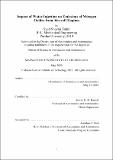Impact of Water Injection on Emissions of Nitrogen Oxides from Aircraft Engines
Author(s)
Zahid, Syed Shayan
DownloadThesis PDF (8.547Mb)
Advisor
Barrett, Steven R. H.
Terms of use
Metadata
Show full item recordAbstract
Aircraft NOₓ emissions form as a result of high-temperature combustion in the engine, and they lead to negative climate and air quality impacts. These emissions increase with temperature, so a NOₓ reduction technique has been proposed where water is injected in different regions of a gas turbine engine to cool down the peak flame temperature and decrease NOₓ production. In previous studies, water injection has been simulated on existing engine models instead of co-optimizing the engine cycle and design characteristics for this technology. This thesis uses pyCycle, a gas turbine cycle analysis tool, to optimize an engine cycle based on this water injection strategy and assess the performance impact of water injection on aircraft missions of varying ranges. This impact is then compared with the emissions impact of water injection estimated by PyCaSo, a combustor modeling tool to evaluate the potential benefits of this technology. It is found that for a turbofan engine, water injection has the potential to reduce NOx emissions by up to 80% without compromising the fuel efficiency of the aircraft. Water injection upstream of the compressors yields performance benefits due to reduction in required compression work, injection downstream of the compressors incurs a penalty to fuel efficiency. The benefit of water injection for NOx reduction in engines operating on rich front-end combustor is more than those running on lean burn configurations. For shorter range missions under 3000 km, the weight penalty due to carrying the additional water on the airplane is offset by the performance benefit of water injection upstream of the compressors depending on the amount of water injected and the engine model, whereas for longer range flights beyond 3000 km, the water weight penalty outweighs the performance benefit in most cases.
Date issued
2022-05Department
Massachusetts Institute of Technology. Department of Aeronautics and AstronauticsPublisher
Massachusetts Institute of Technology